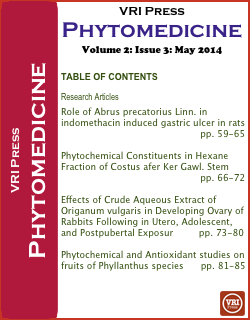
Phytochemical and Antioxidant studies on fruits of Phyllanthus species
Abstract
The genus Phyllanthus (Euphorbiaceae) is widely used in the Indian system of traditional medicine and is reported to have various biological activities. In this study, the polyphenol and flavonoid contents of P. acidus, P. emblica and P. fraternus were quantitated. The fruits of P. acidus, P. emblica and P. fraternus were collected and shade dried. The shade dried plant material were extracted with 95% methanol under sonication and the antioxidant activities were investigated using in vitro assays along with the determination of phytochemical constituents (total polyphenol and total flavonoid). Their ability to salvage were extensively investigated with in vitro DPPH• scavenging assays. The extract exhibited significant antioxidant properties and the observed biological activities in this study provide scientific validation of ethno medicinal use of this plant.
Keywords
References
Kohen R, Nyska A: Oxidation of biological systems: oxidative stress phenomena, antioxidants, redox reactions, and methods for their quantification. Toxicol Pathol 2002, 30:620-650.
http://dx.doi.org/10.1080/01926230290166724
Ames BN, Shigenaga MK, Hagen TM: Oxidants, antioxidants, and the degenerative diseases of aging. Proc Natl Acad Sci U S A 1993, 90:7915-7922.
http://dx.doi.org/10.1073/pnas.90.17.7915
Prior RL: Fruits and vegetables in the prevention of cellular oxidative damage. Am J Clin Nutr 2003, 78:570S-578S.
Weisburger JH: Mechanisms of action of antioxidants as exemplified in vegetables, tomatoes and tea. Food Chem Toxicol 1999, 37:943-948.
http://dx.doi.org/10.1016/S0278-6915(99)00086-1
Santos AR, Filho VC, Yunes RA, Calixto JB: Analysis of the mechanisms underlying the antinociceptive effect of the extracts of plants from the genus Phyllanthus. Gen Pharmacol 1995, 26:1499-1506.
http://dx.doi.org/10.1016/0306-3623(95)00030-5
Unander DW, Webster GL, Blumberg BS: Usage and bioassays in Phyllanthus (Euphorbiaceae). IV. Clustering of antiviral uses and other effects. J Ethnopharmacol 1995, 45:1-18.
http://dx.doi.org/10.1016/0378-8741(94)01189-7
Harborne JB: Phytochemical Methods: A Guide to Modern Techniques of Plant Analysis New York; 1998.
Singleton VL, Orthofer R, and Lamuela-Ravent’os RM: Analysis of total phenols and other oxidation substrates and antioxidants by means of folin-ciocalteu reagent. Methods in Enzymology 1998, 299:152–178.
http://dx.doi.org/10.1016/S0076-6879(99)99017-1
Calixto JB, Santos AR, Cechinel Filho V, Yunes RA: A review of the plants of the genus Phyllanthus: their chemistry, pharmacology, and therapeutic potential. Med Res Rev 1998, 18:225-258.
http://dx.doi.org/10.1002/(SICI)1098-1128(199807)18:4<225::AID-MED2>3.0.CO;2-X
Dewanto V, Wu X, Adom KK, Liu RH: Thermal processing enhances the nutritional value of tomatoes by increasing total antioxidant activity. J Agric Food Chem 2002, 50:3010-3014.
http://dx.doi.org/10.1021/jf0115589
Prieto P, Pineda M, Aguilar M: Spectrophotometric quantitation of antioxidant capacity through the formation of a phosphomolybdenum complex: specific application to the determination of vitamin E. Anal Biochem 1999, 269:337-341
http://dx.doi.org/10.1006/abio.1999.4019
Oyaizu M: Studies on products of browning reaction prepared from glucoseamine. Jpn J Nutri 1986, 44:307–315.
http://dx.doi.org/10.5264/eiyogakuzashi.44.307
Cuendet M, Hostettmann K, and Potterat O: Iridoid glucosides with free radical scavenging properties from Fragrea blumei. Helvetica Chimica Acta 1997, 80:1144–1151.
http://dx.doi.org/10.1002/hlca.19970800411
Yen GC, Duh PD, Tsai CL: Relationship between antioxidant activity and maturity of peanut hulls. J Agric Food Chem 1993, 41:67–70.
http://dx.doi.org/10.1021/jf00025a015
Siddhuraju P, Mohan PS, Becker K: Studies on the antioxidant activity of Indian laburnum (Cassia fistula L.): a preliminary assessment of crude extracts from stem bark, leaves, flowers and fruit pulp. Food Chem 2002, 79:61–67.
http://dx.doi.org/10.1016/S0308-8146(02)00179-6
Bhandari MR, Kawabata M: Organic acid, phenolic content and antioxidant activity of wild yam (Dioscorea spp.) tubers of Nepal. Food Chem 2004, 88:163–168.
http://dx.doi.org/10.1016/j.foodchem.2003.12.027
Yang QM, Pan XH, Kong WB, Yang H, Su YD, Zhang L, Zhang Y, Yang Y, Ding L, Liu G: Antioxidant activities of malt extract from barley (Hordeum vulgare L.) toward various oxidative stress in vitro and in vivo. Food Chem 2010, 118:84–89.
http://dx.doi.org/10.1016/j.foodchem.2009.04.094
Zhao HF, Dong JJ, Lu J, Chen J, Li Y, Shan LJ, Lin Y, Fan W, Gu G: Effects of extraction solvent mixtures on antioxidant activity evaluation and their extraction capacity and selectivity for free phenolic compounds in barley (Hordeum vulgare L.). J Agric Food Chem 2006, 54:7277.
http://dx.doi.org/10.1021/jf061087w
Duh PD, Tu YY, Yen GC: Antioxidant activity of the aqueous extract of harnjyur (Chrysanthemum morifolium Ramat). Lebensmittel-Wissenschaft and Technologie 1999, 32:269-277.
Gordon MH: The mechanism of antioxidant action in vitro 1990. In: BJF Hudson (Ed.), Food antioxidants Elsevier Applied Science, London, p. 1-18.
http://dx.doi.org/10.1007/978-94-009-0753-9_1
Shahidi F, Janitha PK, Wanasundara PD: Phenolic antioxidants. CRC Critical Rev. Food Science Nutrition. 1992, 32:67-103.
http://dx.doi.org/10.1080/10408399209527581
Rice-Evans CA, Miller NJ, Paganga G: Structure-antioxidant activity relationships of flavonoids and phenolic acids. Free Rad Biol Med 1996, 20:933–956.
http://dx.doi.org/10.1016/0891-5849(95)02227-9
Kumar GS, Nayaka H, Dharmesh SM, Salimath PV: Free and bound phenolic antioxidants in amla (Emblica officinalis) and turmeric (Curcuma longa). Journal of Food Composition and Analysis 2006,19:446–452.
http://dx.doi.org/10.1016/j.jfca.2005.12.015
DOI: http://dx.doi.org/10.14259%2Fpm.v2i3.148
Refbacks
- There are currently no refbacks.






